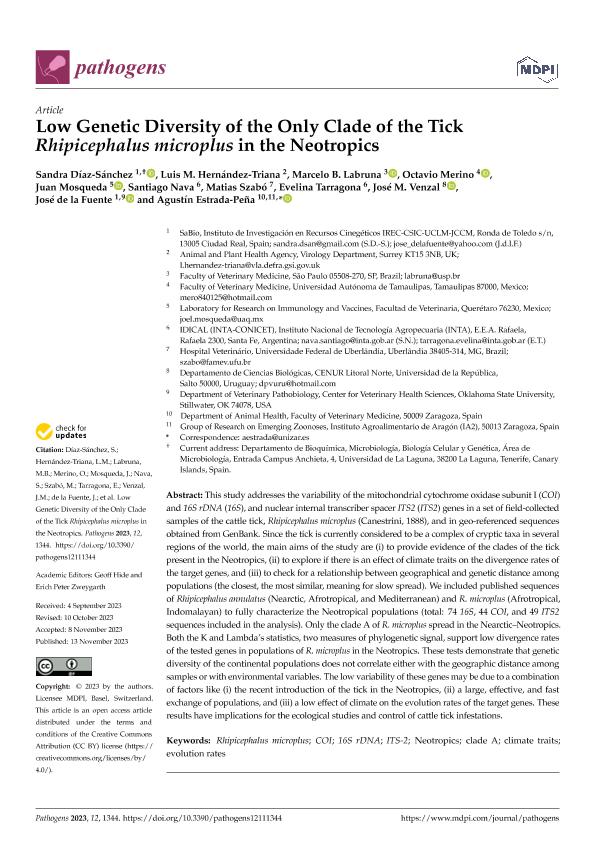Mostrar el registro sencillo del ítem
dc.contributor.author
Díaz Sánchez, Sandra

dc.contributor.author
Hernández Triana, Luis M.
dc.contributor.author
Labruna, Marcelo B.
dc.contributor.author
Merino, Octavio
dc.contributor.author
Mosqueda, Juan
dc.contributor.author
Nava, Santiago

dc.contributor.author
Szabó, Matias
dc.contributor.author
Tarragona, Evelina Luisa

dc.contributor.author
Venzal, José M.
dc.contributor.author
de la Fuente, José
dc.contributor.author
Estrada Peña, Agustín
dc.date.available
2024-02-16T12:20:34Z
dc.date.issued
2023-11
dc.identifier.citation
Díaz Sánchez, Sandra; Hernández Triana, Luis M.; Labruna, Marcelo B.; Merino, Octavio; Mosqueda, Juan; et al.; Low Genetic Diversity of the Only Clade of the Tick Rhipicephalus microplus in the Neotropics; Multidisciplinary Digital Publishing Institute; Pathogens; 12; 11; 11-2023; 1-19
dc.identifier.uri
http://hdl.handle.net/11336/227163
dc.description.abstract
This study addresses the variability of the mitochondrial cytochrome oxidase subunit I (COI) and 16S rDNA (16S), and nuclear internal transcriber spacer ITS2 (ITS2) genes in a set of field-collected samples of the cattle tick, Rhipicephalus microplus (Canestrini, 1888), and in geo-referenced sequences obtained from GenBank. Since the tick is currently considered to be a complex of cryptic taxa in several regions of the world, the main aims of the study are (i) to provide evidence of the clades of the tick present in the Neotropics, (ii) to explore if there is an effect of climate traits on the divergence rates of the target genes, and (iii) to check for a relationship between geographical and genetic distance among populations (the closest, the most similar, meaning for slow spread). We included published sequences of Rhipicephalus annulatus (Nearctic, Afrotropical, and Mediterranean) and R. microplus (Afrotropical, Indomalayan) to fully characterize the Neotropical populations (total: 74 16S, 44 COI, and 49 ITS2 sequences included in the analysis). Only the clade A of R. microplus spread in the Nearctic–Neotropics. Both the K and Lambda’s statistics, two measures of phylogenetic signal, support low divergence rates of the tested genes in populations of R. microplus in the Neotropics. These tests demonstrate that genetic diversity of the continental populations does not correlate either with the geographic distance among samples or with environmental variables. The low variability of these genes may be due to a combination of factors like (i) the recent introduction of the tick in the Neotropics, (ii) a large, effective, and fast exchange of populations, and (iii) a low effect of climate on the evolution rates of the target genes. These results have implications for the ecological studies and control of cattle tick infestations.
dc.format
application/pdf
dc.language.iso
eng
dc.publisher
Multidisciplinary Digital Publishing Institute
dc.rights
info:eu-repo/semantics/openAccess
dc.rights.uri
https://creativecommons.org/licenses/by/2.5/ar/
dc.subject
16S RDNA
dc.subject
CLADE A
dc.subject
CLIMATE TRAITS
dc.subject
COI
dc.subject
EVOLUTION RATES
dc.subject
ITS-2
dc.subject
NEOTROPICS
dc.subject
RHIPICEPHALUS MICROPLUS
dc.subject.classification
Otras Ciencias Veterinarias

dc.subject.classification
Ciencias Veterinarias

dc.subject.classification
CIENCIAS AGRÍCOLAS

dc.title
Low Genetic Diversity of the Only Clade of the Tick Rhipicephalus microplus in the Neotropics
dc.type
info:eu-repo/semantics/article
dc.type
info:ar-repo/semantics/artículo
dc.type
info:eu-repo/semantics/publishedVersion
dc.date.updated
2024-02-02T15:30:39Z
dc.identifier.eissn
2076-0817
dc.journal.volume
12
dc.journal.number
11
dc.journal.pagination
1-19
dc.journal.pais
Suiza

dc.journal.ciudad
Berna
dc.description.fil
Fil: Díaz Sánchez, Sandra. Instituto de Investigación en Recursos Cinegéticos; España
dc.description.fil
Fil: Hernández Triana, Luis M.. Animal And Plant Health Agency; Reino Unido
dc.description.fil
Fil: Labruna, Marcelo B.. Universidade de Sao Paulo; Brasil
dc.description.fil
Fil: Merino, Octavio. Universidad Autónoma de Tamaulipas; México
dc.description.fil
Fil: Mosqueda, Juan. Laboratory for Research on Immunology and Vaccines; México
dc.description.fil
Fil: Nava, Santiago. Consejo Nacional de Investigaciones Cientificas y Tecnicas. Centro Cientifico Tecnologico Conicet - Santa Fe. Instituto de Investigacion de la Cadena Lactea. - Instituto Nacional de Tecnologia Agropecuaria. Centro Regional Santa Fe. Estacion Experimental Agropecuaria Rafaela. Instituto de Investigacion de la Cadena Lactea.; Argentina
dc.description.fil
Fil: Szabó, Matias. Universidade Federal de Uberlandia; Brasil
dc.description.fil
Fil: Tarragona, Evelina Luisa. Consejo Nacional de Investigaciones Cientificas y Tecnicas. Centro Cientifico Tecnologico Conicet - Santa Fe. Instituto de Investigacion de la Cadena Lactea. - Instituto Nacional de Tecnologia Agropecuaria. Centro Regional Santa Fe. Estacion Experimental Agropecuaria Rafaela. Instituto de Investigacion de la Cadena Lactea.; Argentina
dc.description.fil
Fil: Venzal, José M.. Universidad de la Republica; Uruguay
dc.description.fil
Fil: de la Fuente, José. Oklahoma State University; Estados Unidos. Instituto de Investigación en Recursos Cinegéticos; España
dc.description.fil
Fil: Estrada Peña, Agustín. Instituto Agroalimentario de Aragón; España. Faculty of Veterinary Medicine; España
dc.journal.title
Pathogens
dc.relation.alternativeid
info:eu-repo/semantics/altIdentifier/url/https://www.mdpi.com/2076-0817/12/11/1344
dc.relation.alternativeid
info:eu-repo/semantics/altIdentifier/doi/https://doi.org/10.3390/pathogens12111344
Archivos asociados
